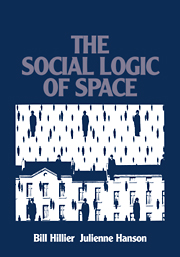Book contents
- Frontmatter
- Contents
- Preface
- Acknowledgements
- Introduction
- 1 The problem of space
- 2 The logic of space
- 3 The analysis of settlement layouts
- 4 Buildings and their genotypes
- 5 The elementary building and its transformations
- 6 The spatial logic of arrangements
- 7 The spatial logic of encounters: a computer-aided thought experiment
- 8 Societies as spatial systems
- Postscript
- Notes
- Index
7 - The spatial logic of encounters: a computer-aided thought experiment
Published online by Cambridge University Press: 18 December 2009
- Frontmatter
- Contents
- Preface
- Acknowledgements
- Introduction
- 1 The problem of space
- 2 The logic of space
- 3 The analysis of settlement layouts
- 4 Buildings and their genotypes
- 5 The elementary building and its transformations
- 6 The spatial logic of arrangements
- 7 The spatial logic of encounters: a computer-aided thought experiment
- 8 Societies as spatial systems
- Postscript
- Notes
- Index
Summary
SUMMARY
The argument then proceeds by showing that, using this framework, a naive computer experiment can generate a system with not only some of the most elementary properties of a society, but also requiring some of its reproductive logic. These simple initial ideas are then extended to show how certain fundamental social ideas, especially that of class, may be given a kind of spatial interpretation through the notion of differential solidarity – it being argued that spatial form can only be understood in relation to social solidarities. Furthermore it must first be understood that societies are never one single form of solidarity but relations between different forms of solidarity. Space is always a function of these differential solidarities.
A naive experiment
Considered as an arrangement, then, spatial order can begin to acquire some markedly sociological and semantic properties. Aspects of what we might be tempted to call the social meaning of space can be shown to be, after all, a matter of how relational patterns are produced, controlled and reproduced. The word meaning seems inadequate to describe such cases. It seems to be not merely a reflection of society that appears in space, but society itself.
But what is it about society that can require complexity and subtlety in its spatial order? The answer seems to require the proposition that society is of its nature in some sense a physical system. We may have already assumed as much in arguing that the physical arrangement of space by societies is a function of the forms of social solidarity.
- Type
- Chapter
- Information
- The Social Logic of Space , pp. 223 - 241Publisher: Cambridge University PressPrint publication year: 1984



